BY LETTER
Arcadia (Beta Comae Berenices)
Galactography > Regions of Space > Inner Sphere
Galactography > Systems and Worlds > Systems & Worlds A - B
Galactography > Sephirotic Empires > Zoeific Biopolity
Galactography > Systems and Worlds > Systems & Worlds A - B
Galactography > Sephirotic Empires > Zoeific Biopolity
Inner Sphere world with extreme climate fluctuations due to non-standard terraforming | |
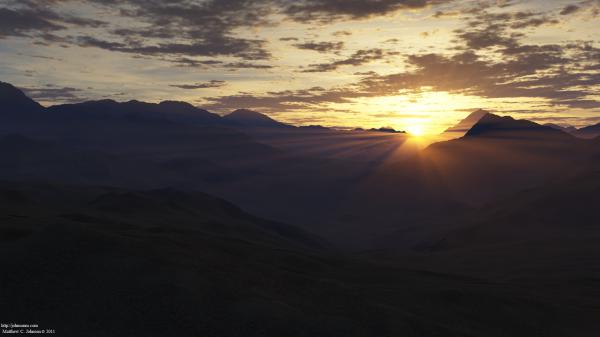 Image from Matthew C. Johnson | |
| Winter sunset in the mountains of Arcadia | |
Arcadia- Data Panel | |
| System | Chloris - Beta Comae Berenices |
|---|---|
| Location | Inner Sphere, 29 ly from Sol |
| Star | G0V |
| Luminosity | 1.11 x Sol |
| Planets | The Chloris system includes several small terrestrial worlds, a superterrestrial world and three gas giants. See main article; The Chloris System. |
| Arcadia | Orbital characteristics: - Semi-major axis: 186,200,000 km (1.245 AU) - Orbital period: 473.1 days (1.295 years) - Eccentricity: 0.028 - Inclination: 1.514° Physical characteristics: - Type: HydroTerrestrial LapiRhean MariTepidal AquaGaian - Mass: 8.403E+24 kg (1.407 x Earth) - Radius: 7,085.1 km (1.112 x Earth) - Oblateness: 0.006 - Density: 5,640 kg/m^3 - Mean surface acceleration: 11.17 m/s^2 (1.139 g) - Rotation period: 61,308 s (17.03 hr) - Obliquity: 17.43° - Albedo: 0.335 - Mean insolation: 1,336 W/m^2 (0.981 x Earth) - Mean surface temperature: 295 K Atmosphere: - Surface pressure: 236,100 Pa (2.361 bar) - Composition: 98.7% nitrogen, 1.2% argon, 0.1% carbon dioxide, trace amounts of methane Satellites: - Chloe: Apnean Semi-major axis = 494,395 km, Orbital period = 33.76 days, Eccentricity = 0.460, Mass = 5.526E+20 kg, Radius = 32.5 km ----------------------------------------------- Arcadia was one of the first worlds to be colonised by Terragens. A non-standard variety of terraformation occurred in the First Federation era, leading to the development of cyclic climate changes and development of communal hive culture. The Arcadians introduced their distinctive style of genetic engineering and biotech to numerous worlds, and became an important member of the Zoeific Biopolity. |
 Image from The Astronomer and Steve Bowers | |
| Arcadia in the Long Winter | |
| Geography | Arcadia is mostly rocky with a moderate-sized metallic core. It has a diameter of 14170.2 kilometres, a surface gravity of 1.139 g and a mean temperature shifting between 17 C in the warm intervals and 2 C in the cold intervals. 80% of the surface is water. The day is just 17.3 hours long, the axial tilt 17.4 degrees. Before the attempt at remote terraforming Arcadia was an Eogaian world with a thick reducing atmosphere; currently the world is subject to drip-and-plume tectonics, although plate tectonics should start to develop in less than a billion years. Terraformation was commenced in the 970s using gengineered organisms to release oxygen by various means. However the processes used resulted in an alternating cycle of warm and cool periods, about 150 years in length. Although this cycle could have been adjusted later, when ecopoeisis technology became more advanced, the Arcadians chose to keep their unique climate and environment with only minor adjustments. The small continent Elysia is a gently rising highland area in the Northern Hemisphere. In the south two subcontinents can be found; the hospitable Thessalia and the dry and mountainous Thrakia. Several major islands, called Flora, Narcissus, Echo, Zephyr and Chiron can be found in the midlatitudes. The southern ocean sports many archipelagos and atolls, with names picked from Greek mythology and jokes among the first colonists. The old colony was located on the shores of Elysia close to Flora, but today there exists Hives on all the main islands and Elysia as well as on the atolls. Flora is a hospitable subtropical island during the warm intervals and is the main location of the population in the Current Era |
|---|---|
| Artificial Intelligences | Wallace, the venerable terraforming Hyperturing departed this system in the Late First Federation era. Several other transapient beings maintain avatars on various planets in this system, notably Bridda, a Zoeific Lifegiver who has helped with the development of diverse biospheres on the worlds Daphnis, Dryas, and Crocus. |
| s allegiance | Bridda is a S:2 Lifegiver loyal to the Zoeific Biopolity and its philosophy of biological development. The Chloris System is also host to a small number of prefects of S:1 level, who help to regulate those planets which owe allegiance to the Solar Dominion. |
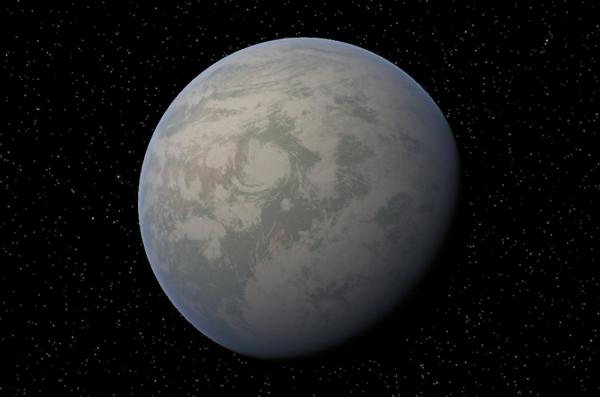 Image from The Astronomer and Steve Bowers | |
| Arcadia Before Terraforming | |
Jonathan Ellis-Khayama, Interstellar Diary
The Early Colony
The multinational sleepership Arkady was launched toward Beta Com in 518 AT, one of the first manned interstellar missions. This ship with its human cargo of three hundred sleepers took 290 years to arrive. The colonists examined the worlds of Daphnis, Crocus and Dryas, but decided to establish a surface habitat on the surface of Arcadia, a lifeless Earth-like planet with an atmosphere rich in nitrogen. This world had been observed remotely from Solsys, and tentatively selected as a possible target for future colonisation. Although the colonists could not breathe the atmosphere, they would have access to a wide range of resources, especially carbon, hydrogen, oxygen and nitrogen. The first domed habitat was erected on the surface of Arcadia in 812 AT. The colonists were unsuccessful in their efforts to contact Solsys, which caused some consternation.For the next one hundred and sixty years the colonists gradually expanded their foothold on this world, creating low worldhouses for agriculture (although much of their food was grown in vats) and trying to develop organisms which could survive on the surface and, perhaps, eventually modify it to become more friendly to humans and other terragen life. Although they achieved many interesting results, they were not very far along this path when (in 964) they finally received a message from the old Solar System, inviting them to join the Federation of Sophonts. The colonists, now more than 4000 strong, sent a reply back in the affirmative, but even before their message could reach its destination they were contacted (in 972) by an approaching vessel coming from the direction of the Solar System.
The Arrival of Wallace
The probeship carried only one occupant - a transapient who called emself Wallace, after the naturalist who co-discovered evolution. This entity declared emself an expert in bioengineering and that e was determined to attempt the terraformation of this planet. Arcadia, or so e said, was one of the most promising candidates for terraformation in the local volume, and it should be possible to achieve good results using only the resources available on this world. Wallace had once been a specialist superturing AI working with the corporation Biotopia, and had ascended to S:1 in the Technocalypse periodWallace possessed an extensive database of then-current terraformation theory, a range of deconstructed biological templates and a state-of-the-art protein-expression modelling capability. His probe had been launched in 673 AT, with the assistance of the Goddess of Earth, who had appropriated all the boostbeams in Solsys in that era. The atmosphere of Arcadia when Wallace arrived was nearly all nitrogen with a small amount of inert argon, a respectable amount of water vapour, and only 0.1% carbon dioxide. Shortly after his arrival, Wallace unleashed a range of geneered phytoplankton and lichen-like plants intended to create a breathable oxygen-rich atmosphere, mostly by splitting the water of the oceans into its component elements. Some of the excess hydrogen was reacted with the abiogenic carbonates in the planet's crust, but the bulk of the hydrogen was compressed into metallic form and stored or exported for a range of uses off-world.
At the same time Wallace began creating a completely novel biosphere, with animals plants and fungal species designed largely from scratch. As the biosphere increased in scale, the carbon dioxide level began to fluctuate, then to fall. This reduction in CO2 in Arcadia's atmosphere was gradual, but after seventy years the climate of this planet had changed significantly. Arcadia had previously been only slightly cooler than Earth, on average; now the planet had cooled by more than ten degrees centigrade, and was still cooling. On the other hand the atmosphere held a partial pressure of oxygen equal to 0.1 bar, and this was increasing. Already some animal species were thriving on the surface, despite the low oxygen levels and cool climate. Wallace redesigned several of these species to seek shelter underground for part or all of their life cycle.
The Arcadian colonists learnt much from Wallace during this period, and by 1050 AT they had developed a thriving biotech industry of their own, as they expanded their underground complexes and experimented with the new life-forms below and above ground. Several new plant and animal species were created by their researchers, with help and guidance from Wallace, and their design work was often incorporated into the new ecosystems wherever possible. Often these experiments were unsuccessful, leading to the failure of entire biomes and the demise of the associated species. A significant number of Arcadians disagreed with this sort of experimentalism, and returned to the orbiting stations, some going further and setting up habitats on the non-Gaian worlds Dryas and Crocus. Wallace donated large quantities of metallic hydrogen to these departing dissenters, a material which would be useful both as concentrated fuel and propellant, but also useful as a source of volatiles on the dry inner worlds.
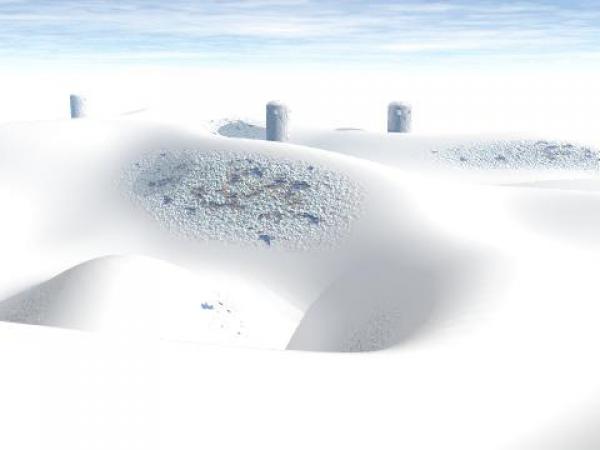 Image from Anders Sandberg | |
| The Surface of Arcadia during the Long Winter, with hives beneath the snow | |
The First Long Winter and the Worker-Rat Hives
The colonists who remained behind on Arcadia became more deeply involved with Wallace's experiments. One particularly successful neogen species which had been developed by Wallace was the Wonaa, or worker-rats; large, mole-like semi-sentient neogens based on giant mole rats, which lived in burrow-like Hives. The Hives were mound-like constructions inhabited by several species of neogen animals and fungi. In the increasingly cold weather the worker-rats dug tunnels and brought back plant material to central fermentation chambers where various species of fungi grew. The fungi became food for the worker-rats and other allied species. Their excrements were gathered into other chambers where other species of fungi and snowplants exploited them. Snowplants were one of the phenotypes developed by the Arcadian researchers, rather than by Wallace. They sent up leaves to the surface, gathering sunlight and carbon dioxide while extracting nutrients and water from the Hive system below. In exchange for being tended the snowplants produced oxygen for the hives, and fruits which formed a major source of nutrients for the hive ecosystem.The Arcadian colonies moved underground, using the engineered fungi and snowplants as food and the Wonaa as workers to extend the hives. The first years were hard, but they could communicate with the worker-rats using sound and chemical languages devised by Wallace. A new form of underground agriculture took form that relied on biology instead of mechanical engineering. The snow-plants were further modified, to supply some rare nutrients for the humans, for increased yields and resistance to some pests. Over the years, the colony grew with the Hives as the modified ecologies flourished, but the surface conditions remained harsh, and the air in the tunnels sometimes became toxic.
In 1120 Wallace started to reverse the cooling and bring an end to the winter conditions. Instead of using sunshaper technology or artificial greenhouse gases such as perfluorocarbons, e decided to release carbon dioxide back into the atmosphere while retaining a relatively high oxygen fraction. As the snows started to melt the first Federation ships arrived, first from Solsys carrying tens of thousands of new colonists from the varied cultures in the old system, and in 1137 a ship arrived from New America (the colony subsequently known as Pacifica). The Arcadians greeted the newcomers with enthusiasm (scaring them a little in the process, since the hive-dwelling Arcadians had many cultural characteristics that were seemingly eccentric). The colonists from Solsys mostly settled on Daphnis, Chloe and Dryas, swelling the ranks of the former Arcadians now living there; on the other hand the New Americans set up new colonies on the moons of Diana, and out on the cold worlds Doris and Galatea.
Over the next few centuries the Arcadians forged close links with the incomers from Beta Virginis, who established the Republic of Virginis in the southern ocean, as well as a number of floating cities in the Arcadian Great Ocean . A smaller but influential group of Solsys colonists also settled on Arcadia, mostly on the temperate equatorial islands which were gradually becoming warmer as the temperatures on this planet rose once more. Arcadians called these incomers 'Deyodors', the smell-less ones, because they did not use the odorous chemical languages favoured by the Hive-dwellers.
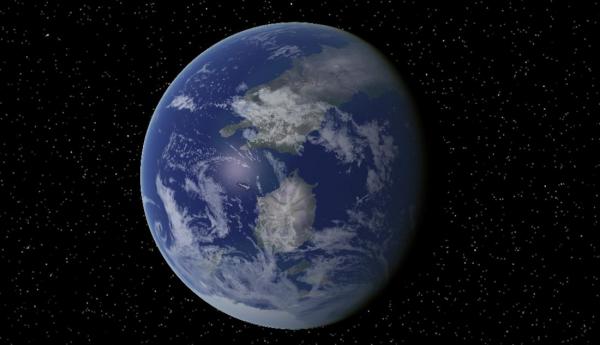 Image from The Astronomer and Steve Bowers | |
| Arcadia in the Long Summer | |
The Long Summer
The first Long Summer lasted 150 standard years (130 Arcadian years), and allowed the neogen biomes that had become established in the tropical zones to spread across the rest of the planet. Many neogen species were subtly modifeid, either by Wallace or eir Arcadian human acolytes, and became established on the surface, including the wonaa worker-rats which began to produce a summer phenotype that lives on the surface as herbivorous herd animals. The hive mounds became covered in vegetation, forming small groves, and the tunnels decayed. The human hive-dwellers also emerged to live on the surface, adapting themselves to tolerate the still-low oxygen partial pressure and the gradually increasing carbon dioxide levels. For the younger generation it was a new and unusual experience. The colony was retrofitted for above ground farming, treatments for agoraphobia instituted and suitable crops developed, with the assistance of the protective Wallace. Some Arcadians remained underground, and maintained their older tunnels.When the O2 partial pressure reached 0.15 bar, and the CO2 reached 5 bar, Wallace initiated another reversal, and the biosphere began to absorb carbon dioxide once again, as the planet entered a gradual autumn. As the cold season approached, the colonists either moved into the Hives once again, or built small surface cities in the tropics, among the small communities of 'deyodors' who lived by the ocean and the salty inland lakes of Flora. The "topsiders" were soon outnumbered by the hive-dwellers, but relations remained cordial. In the autumn the worker-rats began producing the winter phenotype, which seeks out or digs Hives. They gathered all the vegetation they can find and carried underground to feed the fermentation chambers, starting the cycle anew.
In 1309 a FedRep transapient set up an embassy on a moon of Diana. The FedReps were dedicated to maintaining a certain measure of uniformity between the disparate worlds of the First Federation, which was no easy task since all communication between stars at this time was limited by the speed of light. In the case of the Chloris system, the FedRep maintained a purely advisory role and did not intervene in Wallace's sphere of activities.
The next winter period lasted once again 130 Arcadian years, and by the end of this period atmospheric oxygen had stabilised at 0.22 bar. In the deepest winter some of the larger surface species dug holes for themselves and hibernated in subzero temperatures, in some cases freezing solid before thawing out several Arcadian years later. Many separate Hives were established, each with a mixed population of wonaa and humans, who were becoming increasingly alike in behaviour if not appearance. The hives were not unlike kibbutzim: partially self-sufficient, closely knit communities. Under the tutelage of Wallace, biotechnology and ecological management became dominant research areas, and modified life forms were used instead of automation for many purposes. From this time onwards the planet Arcadia was subject to a more-or-less regular cycle of climate change, with the Long Summer lasting on average 131 Arcadian Years followed by a Long Winter of similar length.
The transapient Wallace engineered the phytoplankton of the oceans and the land-plants and lichens to perpetuate the cycling nature of this planet's climate, and then, in 1690, e departed the system in a conversion-drive singleship.
Arcadian Culture in the First Federation era
Now left to their own devices, Arcadian culture flowered into a distinctive and unusual form which it retained until after the Version War period. Instead of non-living construction materials and furniture, the Arcadians used biologically-grown plants and fungi, controlled using growth regulating hormones. Many plants, lichens and fungi produce diamondoid and silicate phytoliths of many shapes and sizes which were used for construction and as tools and jewellery. Arcadian homes incorporated microecologies, utilising cleaning and scavenging creatures, bioluminescent lighting and nutrient distribution integrated with the waste disposal systems. Biological computers were commonplace, and large domesticated animals were used for labour and logistics. To outsiders Arcadians commonly appeared disturbingly unconcerned about being surrounded by symbiotic creatures, including symbiotes creeping through their living clothing that eat dirt and skin flakes as well as gives comfort to their owners. Biotech envirosuits were developed by the Arcadian technicians that enabled individuals to journey into the least hospitable environments on the planet, garments covered in symbiotic and parasitical life support systems and extended sensory organs, the whole looking like a mass of bloodvessels and bladders. Normal Arcadian clothing was generally grown to fit the user and was often still alive when in use. Living clothing could be animal-based or plantbased, and could generally self-repair and adapt to the environment and clean and comfort the owner so long as it was treated with regular nutrient baths. Arcadians often had companion animals, ranging from mammal-like creatures to scavenger multipods, pet lumps and augmented worker-rats that act as servants. Having good control over one's animals is a sign of style.The Arcadian hives expanded across Elysia and the islands of the equatorial sea. The regular great colds turned out to be less limiting than expected as long as work was done underground or in space. During the warm intervals, Arcadians often spent much time and built topside, but the real cities remained safely underground. Arcadian Hives were inconspicuous mounds, topped with a loose collection of white ceramic towers called turres, and sturdy domes. Underneath were kilometres of tunnels, chambers and subways. During the warm seasons the exits were marked by substantial buildings and temporary surface townlets, while during the winter the hives were difficult to spot.
Arcadian government in this era consisted of an overcouncil that advised and guided all the hives, including one representative for each major hive and a number of representatives for the global functions such as off-world relations, ecopoesis, environmental regulation, communications and law. In many of the smaller hives the councils were absent or symbolic, but most hives held regular meetings to discuss policy, since they hives were governed almost exclusively by consensus. Since the Arcadians were increasingly using genetic enhancements to improve their capabilities, the consensus-reaching process became heavily dependent on the interactions between these enhanced individuals. As these interactions were complex and incorporated subtle social and pheromonal signals, outsiders (deyodors) were often baffled. But at this time the Arcadians did not adopt true group mind mental linkages.
Arcadians enjoyed many sports, but the widespread adoption off genetic enhancements made competitiveness less important than playfulness, teamwork and challenge. One popular activity was arachnautics - gliding with the use of a "spinchute", a dense fan of long very thin fibres extruded from a spinneret on the back. Originally it was used as an alternative parachute inspired by the ability of terrestrial spiders to blow long distances in the wind by extruding a silk strand, but the spinchute was soon put to recreational uses. Arachnauts either jump from air vehicles or allow themselves to be lifted by thermals; the experience is somewhere in between ballooning and parachuting.
In the Late First Federation Era most Arcadians were modified significantly in various idiosyncratic ways. The earliest modifications they adopted were for atmospheric tolerance and enhanced senses for their underground habitation, but over time more advanced changes were made. Modified Arcadian humans had an advanced sense of smell and were able to understand Hive signals or track through darkness, with scent glands in the hands enabling chemical communication. Infrared vision via sensory pits just beneath the nose and an extended range of visual wavelengths were ubiquitous mods. Enhanced hearing and ultrasound sonar senses, the ability to internally secrete various drugs or medicines, hibernation at will were also popular.
Around 1720 AT some Arcadians, calling their project Yeti-Yeti, began to develop modifications to survive on the surface during the winters, gaining the ability to shift into a "snowman" form with thick fur and other adaptations. At the same time the Aquarians began to explore developing gills and other aquatic adaptations; modern Aquarians are amphibious and can grow insulating fat and flippers as the seas get colder. Arcadian bioengineering tends towards adaptation, an attitude of being ready for everything as well as a certain delight in doing the impossible.
A minority of Arcadians adopted the Jumper lifestyle, freezing themselves during the Long Winter and only emerging in the warm intervals; they refer to themselves as Summerflies. Arcadians also developed morphs capable of thriving in most of the environments in the Chloris system, and shared these capabilities enthusiastically with the non-Arcadian colonists, the Deyodors of many factions.
Overall Arcadian culture adopted a way of life suited for living underground in close proximity with other species, a tolerance for personal habits and eccentricities combined with a strong feeling of community. Although this rather unkempt and some might say unsanitary lifestyle fell out of favour in the ComEmp era, in more recent times it has been revived in a modified (and some say more extreme) form.
Arcadia and The Virginis Combine
In this period the Arcadians were actively working with the inhabitants of Daphnis, Dryas and Chloe to improve the environments on those worlds using biotechnology, and established a significant number of habitats throughout the system. Many, but not all, of these habitats were microgravity structures, and the Arcadians developed a number of zero-gravity morphs that thrived in these conditions.In the oceans of Arcadia a number of raft-cities had been constructed by the Pacifican incomers; the Arcadian biotechnicians worked with these raft-dwellers to make the cities into organically-grown, self-sufficient biomes, using sunlight, atmosphere and seawater to increase in size and complexity while growing food locally. Each floating raft-house produces a range of edible fruits, while edible fish-like neogens dwell in ponds and in the open sea. The Arcadians developed a human-derived aquatic morphotype, known as an Aquarian, which was capable of working in the sea around and under the raft-cities and shepherded the fish-like denizens of the deep. The Arcadian biotechs also worked with the Pacificans to help them adjust to the cycles of warm and cold conditions and varying atmospheric conditions.
This cooperation between the Arcadians and Pacificans extended to the interstellar stage; by the end of the First Federation Arcadian biotech advisors could be found throughout the worlds of the Virginis Combine, such as Pacifica and MButo, helping the inhabitants adapt to the local conditions and to develop new species compatible with various environments. Arcadian biotech and their culture in general was not universally popular, however, as they often appeared unkempt, malodorous and accompanied by living symbiotes of many shapes and sizes.
However the First Federation was becoming increasingly irrelevant as the power of the transapients increased; in 2210 the FedRep departed for the newly emerging Terragen Federation. In 2512 the Virginis Combine also dissolved, and it was effectively absorbed by the Conver Ambi Despite some misgivings, Arcadian biotechnicians became involved with the Conver empire, assisting them with biotech projects on many worlds. The Conver Ambi often attempted to adapt their colonists to the planets in a system rather than the other way round, and they used a mixture of cyborgisation and genetic modification to achieve this. Arcadian biotechnology was often very useful when adapting to new environments, but over time Conver biotech diverged away from Arcadian biological ideals, and most Arcadian advisers returned home to Chloris.
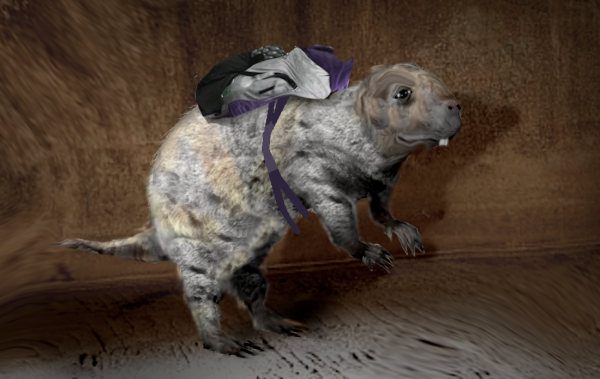 Image from Steve Bowers | |
| The Weem, a provolved, sentient form of the Arcadian worker-rat | |
Arcadia joins the Zoeific Biopolity
The Arcadians were contacted by the Zoeific Biopolity in the Age of Establishment, and in 2890 a Zoeific Lifegiver known as Bridda set up her home in the abandoned computronium nodes left behind by the FedRep on Endymion, a moon of Diana. Arcadian biotechnology, philosophy and lifestyle was found to be thoroughly compatible with Zoeific doctrine, and the Council of Hives joined the Biopolity in 3231.The former Virginis polities on Galatea and Smilax had become Conver Ambi properties when the Combine dissolved in 3932, while the colonies on Daphnis, Crocus and Dryas remained independent, but deeply influenced by Arcadianism. Daphnis in particular was gradually becoming more hospitable, thanks to a variant of sunshaper technology consisting of an organically grown sunshield at the starward L1 point. Daphnis also joined the Biopolity, and soon ecopoesis was occurring on this world, using an experimental ecology imported from Ecotopia.
The remnants of Conver Ambi culture in the Chloris system were examined by a joint mission from the Solar Dominion and Metasoft, who were still working together at this time. A small Metasoft outpost was established at Galatea, while Smilax became the base of operations for Solar Dominion activity in this system. The Solar Dominion began to build near-stellar infrastructure in the system, ostensibly to improve the local boostbeam capabilities.
The Version War and ComEmp eras
But the tensions between the Dominion and the Version Tree were increasing, as the Integration came to an end. The Solar Dominion brought a wormhole to the system and expanded it over the next two centuries, just in time for the Version War. When war was declared, the Metasoft outpost on Galatea was seized by the Dominion and subjugated. Arcadia, as a Biopolity world, maintained its neutrality, In 4230 Metasoft send a fleet of drone warships to relieve Galatea, but these subsophont warcraft were incapable of evading the Dominion's particle beam defences, and were defeated. The Dominion had readily converted their boostbeam facilities throughout the system into effective particle beam weapons.After the War Smilax, Chloe and Dryas joined the Solar Dominion. Daphnis formally joined the Biopolity, and the developing biosphere on this world became increasingly elaborate, under the guidance of ecology engineers from Arcadia, Frog's Head and Ecotopia. During the ComEmp era, an increasing fraction of the population of this system migrated into rotating space habitats, and the biospheres of Daphnis and Arcadia were allowed to develop in a more naturalistic fashion. This change meant the slow decline of classical Arcadian Hive culture, and their empty underground cities were taken over by the Wonaa worker-rats. However the Arcadian biotech specialists were still closely involved with the planet's biosphere, and after some false starts they managed to provolve the worker-rats into full sophonce. They called this new clade the Weem, which had been a familiar term for an underground dwelling back in the earliest days of the colony. The Weem were larger and somewhat more hirsute than the original Wonaa species, had sensitive and powerful hands on their forelimbs and an inquisitive nature.
Biopolity factions from Iota Horologi and Ecotopia established organic bubblehabs in the atmospheres of the gas giants Diana and Adonis, joining existing habitats of a different design built by the Arcadians. Arcadian bubblehabs on these worlds are generally fungoid or saphrophytic in appearance, with many trailing hyphae-like appendages and often accompanied by functional parasites and metasites. Ecotopian bubblehabs generally consist of photosynthetic plant-forms, resembling buoyant Dyson trees; and Genen bubblehabs are often semi-independent and independently mobile animal-like organisms resembling skywhales. Over the subsequent millennia these distinct types of habitat have become less distinct from each other, as the different types have influenced and merged with each other.
In 7698 the Weem, who were now the dominant culture on the surface of Arcadia, provolved the large mining animal species known as the Grabbit. Grabbits were four times as massive as the average Weem, and had been designed to be capable of rapidly burrowing into deep regolith and sediment layers. The Grabbits have developed a distinctive culture of their own, often occupying deep excavations at a lower level than the Weem. Both the Weem and the Grabbits can be found throughout the Biopolity and elsewhere, often assisting with excavations on a wide range of objects. Both clades have diversified further into a wide range of types, in many cases moving completely away from their subterranean roots.
The Current Era
Since the ComEmp period relations between the Solar Dominion and Metasoft have remained cordial, at least in this segment of the Inner Sphere. A small population of Version Tree vecs and biont associates have inhabited the cold, airless world of Galatea and its tiny moons. In 9201 a new cult or faction emerged on, and around, Galatea; the Draben Transcendence were influenced by news of the recently discovered Menexenes, a xenosophont civilisation that exists within the metallic hydrogen layer of a gas giant far away on the Periphery. This faction considered that they could descend into the depths of the largely uninhabited gas giant Pan, and transcend to a higher toposophic level within the planet's metallic hydrogen layer. After constructing a raft of bubblehabs in the upper atmosphere of that planet, in 9406 they descended into the depths and were never seen again. Deep neutrino scans of the planet occasionally indicate that there is some kind of unknown activity in the metallic layers of that world, but it does not seem to follow any recognisable pattern.A curious development on the small world Dryas has attreacted some interest in recent centuries; this world is currently aligned with the Solar Dominion, and is nominally a direct cyberdemocracy where every major decision is made by public vote. In order to influence the voting results, a very small number of individuals have taken to copying themselves numerous times, so much so that they outnumber the regular citizens. Because these copies were gaining undue influence in the political process on this world, the local Dominion prefect has put compensatory weighting algorithms into effect, which are largely incomprehensible to the local modosophonts.
Human Arcadians have returned to the surface of the planet in recent centuries, and have established a new hybrid culture with the provolved Grabbits and the Weem; often the human-derived individuals will alter their bodymorph into something resembling a Weem or a Grabbit, and the provolves will alter their own forms into human morphs, or into more exotic forms. The transapient Lifegiver Bridda has dedicated a cohort of avatars to the study and guidance of this new society, which has some features in common with the ancient Arcadian Hive culture but is significantly more complex and many-faceted.
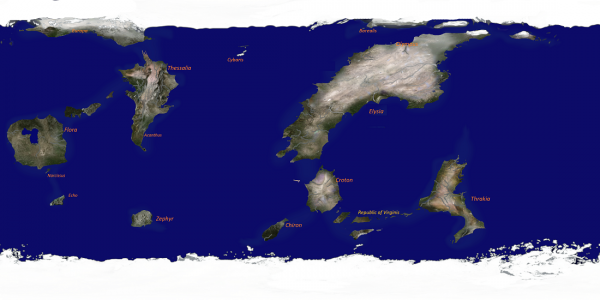 Image from Steve Bowers | |
| Arcadia - Map (showing climate in the Long Summer) | |
Some common language terms (First Federation period)
The dialect of Anglic used in the Chloris system in this era, known as Lingu, included several terms idiosyncratic to Arcadia. Some terms are still in use in the Current Era, often with different meaning and pronunciationAuge: "Augmented animal", especially one with increased intelligence. Also used as a friendly nickname for augmented humans.
Bademinu: "lifeguard", organism or implant to alert rescuers if something happens to the owner.
Comme: "Commensal", animals or people in one's own ecosystem, sharing one's resources. Often meydsoi.
Cortesu: Biocomputer, usually used as a exocortex.
Cryp: Something hidden, surprising. Arcadian aesthetics delight in cryps: secret tunnels, tools with unexpected extra uses, creatures with surprising abilities or just plain jokes.
Deyodor: A person with no smell, slightly derogatory term for offworlders, especially those wearing hermetically sealed envirosuits.
Draz!: Common curse.
Goret: Small, mountain-dwelling piglike animal. Regarded as extremely delicious.
Hippayur "The Hour of Scampering" An afternoon lighthearted exercise for the whole hive. Originally instituted to prevent muscle weakness among the initial colonists as they holed up in the hives, today it is a tradition in many hives to play. Particularly enjoyed by the Weem.
Lihmuschel: A bivalve living on walls in the Hives that has been genetically enhanced to produce light. It also eats certain pests and metasites. Lihmuschel is also used as an epithet for a clever but asocial person, usually a gentle reminder to come and join the fun ("Don't be a lihmuschel, go to the party!").
Lengsete: "Long Summer"; One of the warm 150-year intervals of Arcadia.
Lengsiver "Long Winter"; One of the cold 150-year intervals.
Meydsoi A "Metasite", commensal species in an ecosystem, often a nuisance but not necessarily parasitical.
Natt: A "natural", unmodified human or terragen animal.
Neakke: "Neogenists:" People who favour Arcadian neogens rather than terrestrial ones; opposed by the Terrestrialists who want to introduce more Earth stock.
Ourb: "Tribe", a social network within a Hive (or between several) sharing the same values and goals. Tribal politics were complex and an important aspect of this era..
Perme: Either somebody wanting to live permanently underground or overground, or use an adaptation like aquarianism all the time.
Plenn: "Planning" The planning done by parents and genetic designers before a child is conceived.
Riste: "Aristocrat," Somebody believing himself to be above the hive or outside the social network.
Splik: Wedding. Literally, a 'splice'. Also used for genetically spliced organisms.
Stege: "Stag". People with leadership enhancements to their brain. Stags tend to be very charismatic, ambitious and social people, even if they also can be a bit competitive against each other. "Stags" are also a surface-dwelling neogen animal that hibernate in ice for decades at a time during the Long Winter
Strosse: Street, a major tunnel.
Stythe: Toxic air in the tunnels, usually high carbon dioxide or low oxygen, but sometimes more dangerous gases from fermentation.
Terreake : "Terrestrialists", people who want to introduce more terragen organisms into Arcadia; opposed by the Neogenists who want to base things more on Arcadian stock.
Weem: an underground home, later the provolved species that was developed from the worker-rats.
Whe: "Whiff" . Somebody's odour presence ("You have an angry whiff, Pjotr, should I stay away?").
Wonaa: "Worker-rats". Neogen species similar to mole-rats, often aiding the colonists in maintaining the tunnels. In the Current era a provolved species, known as the Weem, have become fully sophont and gained their freedom.
Related Articles
- Arcadian Biotopics - Text by M. Alan Kazlev
Arcadian megacorp; created the weem and many other popular neogens. - Chloris (Beta Comae Berenices)
- GaianTundral Subtype
- Ice Age
- Xanthric Flowerweed
Appears in Topics
Development Notes
Text by Updated 2021 by Steve Bowers, The Astronomer and Dangerous Safety
From an original article by Anders Sandberg, updated by QwertyYerty 2017
Initially published on 22 September 2004.
From an original article by Anders Sandberg, updated by QwertyYerty 2017
Initially published on 22 September 2004.
Additional Information
Updated 26/11/19, 12/2/21






